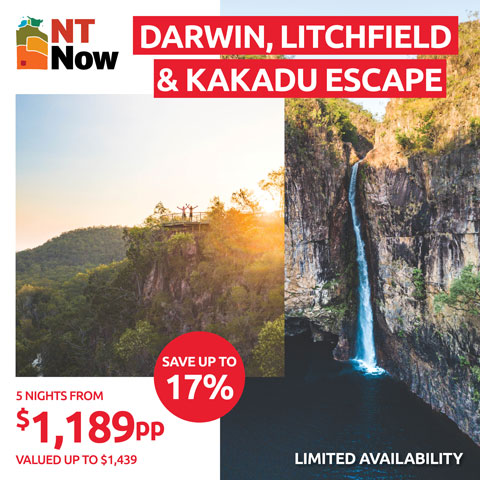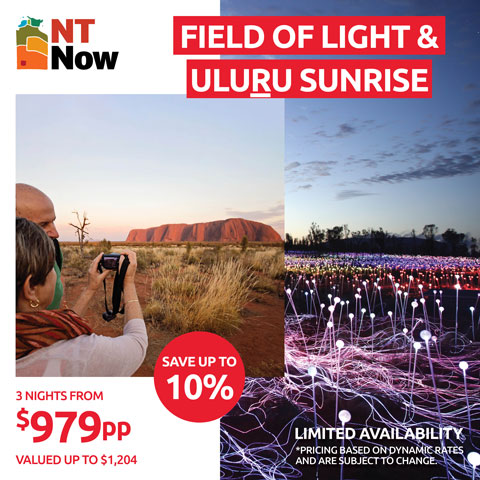Spend your day in exclusive, natural swimming holes
There’s nothing like relaxing in stunning swimming holes that dot the Red Centre’s red landscape!
Ellery Creek, also known by its Aboriginal name Udepata, is not only a swimming wonderland, but also a special meeting point for the Arrernte people on the fish and honey ant dreaming trail. Nestled within the wild swimming wonderland of the Tjoritja West MacDonnell National Park, Ellery Creek is quite remarkable. With plenty of places to chill and relax within the towering red cliffs that surround the waterhole, it’s somewhere you could easily wallow away a day doing some hardcore chilling (there’s also a campground here).
Glen Helen (Yapalpe) pole-vaults the concept of a roadhouse into road tripping Narnia. A short stroll from the car park and accommodation guides visitors to a serene hideaway on the Finke River, with shaded banks set beneath huge quartzite cliffs that transform in colour as the sun does her thing. You’ll share the spot with a throng of birds, reptiles and marsupials. For the tougher fingered there are deep-water soloing opportunities, as well as a cheeky rope swing and secret beach if you swim through to the right.
Only 500m from the car, Ormiston Gorge, also known as Kwartatuma, has a large, open sandy area to relax on before jumping into the cooling waters. A huge pool surrounded by the sandy verges creates the perfect opportunity for a group charge into the water. To truly earn a dip though, you should attempt the 3-4 hour Ormiston Pound Walk, a loop hike from the car park. You can rely on this one to deliver the goods all year too: it’s a permanently filled waterhole for a cooling year-round escape!
.jpg)
Image: Enjoying the relaxing natural atmosphere of Ormiston Gorge in the West MacDonnell Ranges (credit Paddy Palin & Tourism NT)
Exploring the historic township of Alice
The Royal Flying Doctor Service Alice Springs Facility provides an opportunity to see, experience & learn through the wonder of technology as this facility brings history to life. Enjoy the heroic tales of the birth and growth of the RFDS in the original RFDS Alice Springs working base that commenced in 1939 and learn the importance of the RFDS to outback Australians and the medical care required to service isolated regions.
The most visited landmark in Alice Springs, Anzac Hill is the ideal spot for an overview of the town with the lookout offering a panoramic view of township it’s beautiful surrounding ranges. The Anzac Hill Memorial was unveiled on 25 April 1934 (Anzac Day) and was originally dedicated to all those members of the armed services who had paid the supreme sacrifice during World War I. It has now become a memorial to all those who have served in the defence of their country during all wars in which Australia has participated.
Alice Springs Telegraph Station is a historic museum precinct with indoor and outdoor displays, presenting the story of the connection of Australia to the rest of the world through Telegraph Communication in 1871. Since being declared protected as a Historical Reserve in 1963, the Alice Springs Telegraph Station has become the best restored in Australia with a commitment to authenticity, and the restored stone buildings house furnishings and artefacts from early last century. At the attraction you will experience a guided tour of the heritage precinct, visit the original "Alice Spring" and learn about the origins of the town.
The Museum of Central Australia is based in the heart of Alice Springs and tells the story of the region's unique natural history, following the evolution of the landscape and the fascinating creatures that inhabited it. From the big bang to the present day, meteorite fragments, fossils and interpretive displays detail the geological history of Central Australia. The Museum of Central Australia also houses the Strehlow Research Centre, one of Australia's most important collections of film, sound, archival records and museum objects relating to Indigenous ceremonial life.
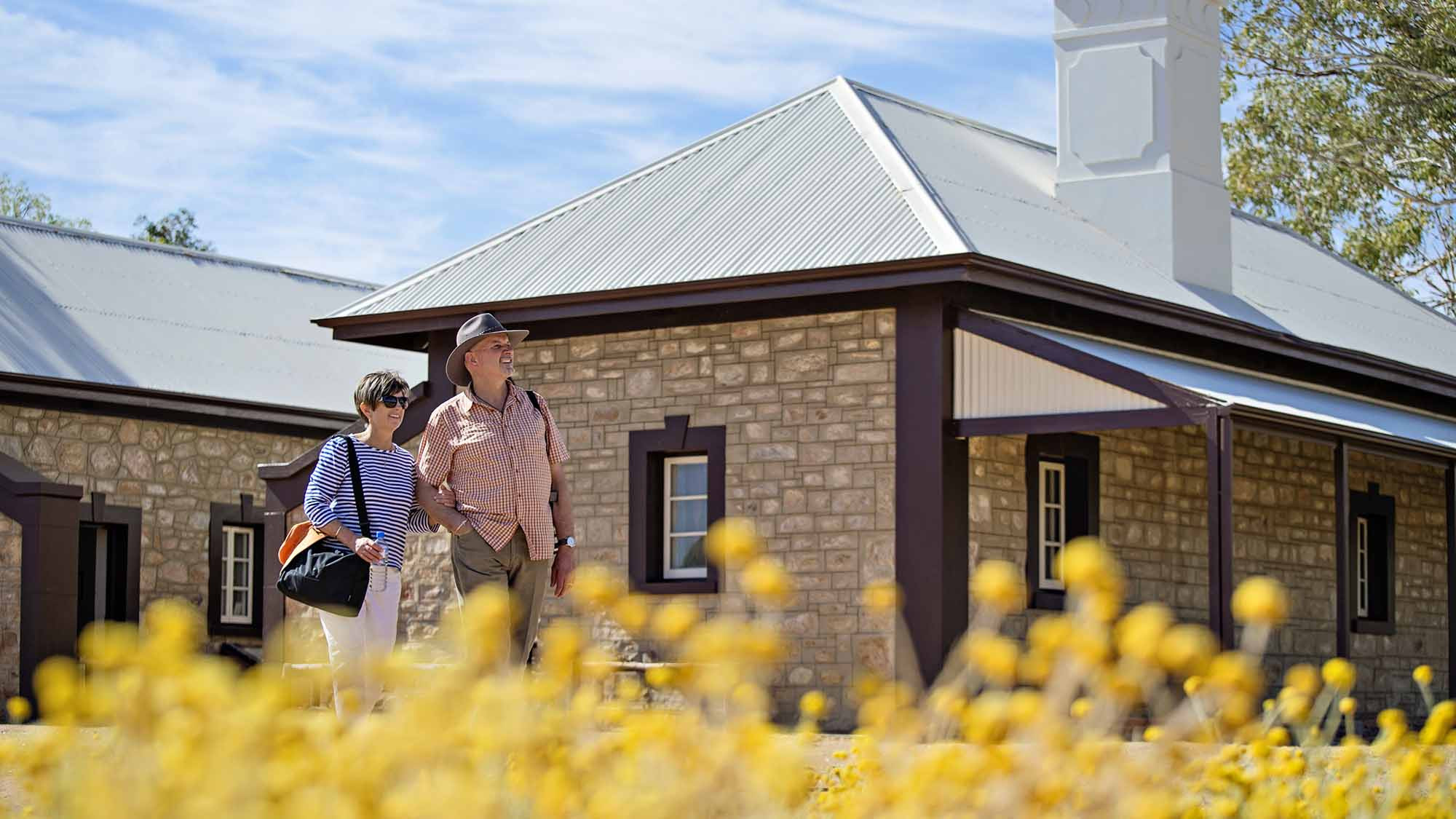
Image: Wandering the gardens of the Alice Springs Telegraph Station Historical Reserve (credit Shaana McNaught & Tourism NT)
Amazing animal experiences
There are plenty of ways to find yourself on the back of a striding camel as you admire the stretching outback landscape around you. These magnificent animals and original outback heroes make great travel companions and give you the opportunity to view the Red Centre like never before. You can also head out on a sunset tour where the silence of the bush before dusk is a magical experience as you trek through the ranges at sunset.
At Alice Springs Desert Park you’ll find a range of options to fill your time with adventure and interesting experiences. At the Eagle Encounter you’ll find your heart racing as you get up close with Australia’s largest bird of prey, the majestic wedge-tailed eagle and get close to the golden-brown dingoes. Walk the Land will immerse you in the spirituality of the living desert as you admire local wildlife and learn hunting and gathering techniques, all while lead by an expert guide.
First established in 2005, The Kangaroo Sanctuary is one of Alice Springs most popular attractions and gives you the opportunity to get up close and personal with Australia’s favourite bounding animal – the kangaroo! The sanctuary’s mission is to educate and encourage people to rescue and care for kangaroos and other local wildlife and animals. It is home to both adult kangaroos and rescued orphaned baby kangaroos which are always keen for a cuddle with caring guests!
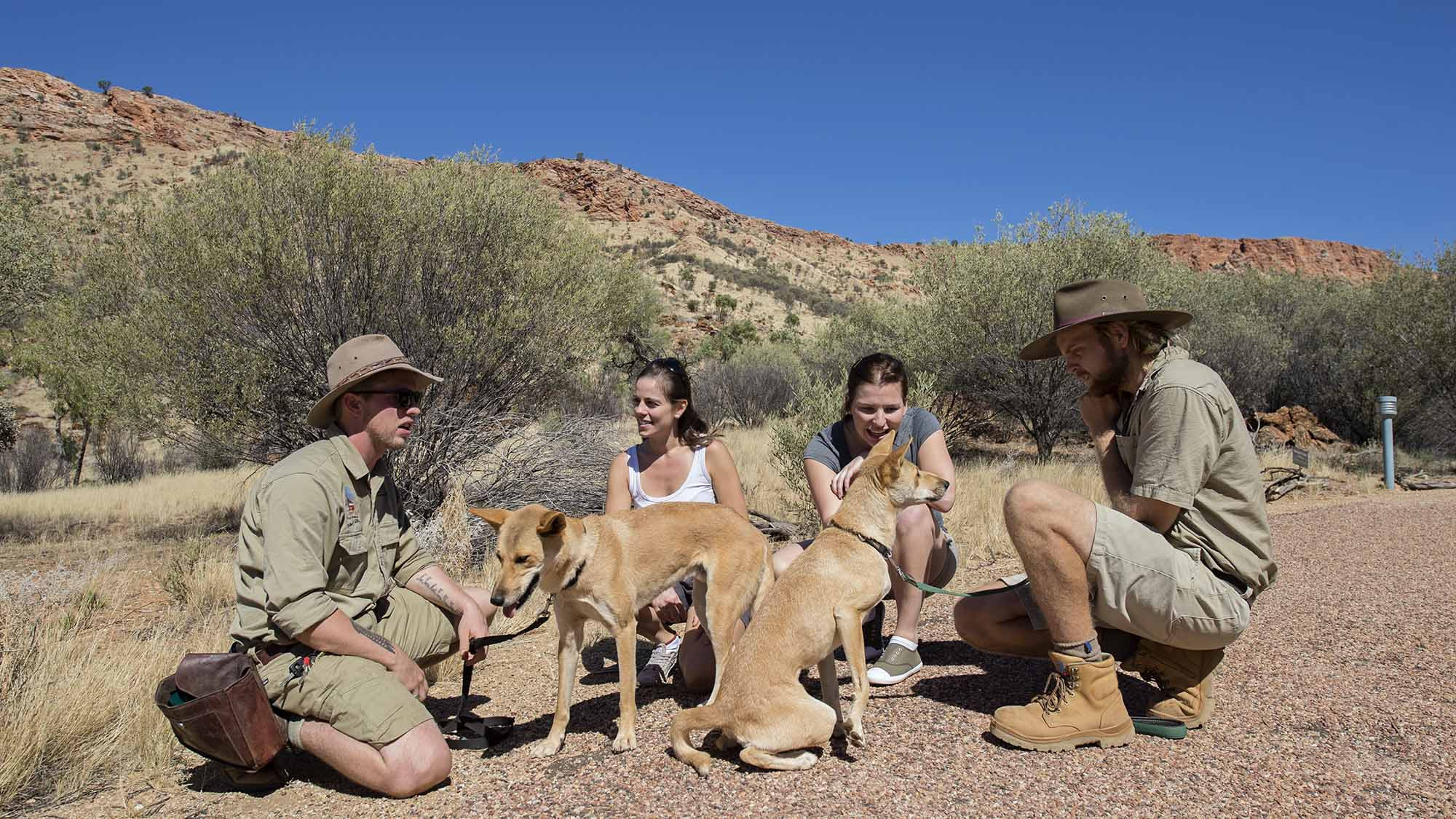
Image: Enjoying the Dingo Experience at Desert Park Alice Springs (credit Shaana McNaught & Tourism NT)
Unique art experiences
Known as the keeping place of stories, Araluen Arts Centre holds some of the most significant works of art in Central Australia and brings to the stage world class performances from around the nation (and at times the world). The Araluen Galleries showcase the beginning and continuing development of the Contemporary Aboriginal art movement, particularly of Central Australia and the Western Desert Region as well as significant local contemporary artists in their response to place. The Araluen Art Collection includes original artworks by renowned watercolourist Albert Namatjira and his artistic response to the Central Australian landscape, displayed in rotation in the Galleries, which themselves are only minutes from the spectacular West MacDonnell Ranges and the country that gave his work birth.
The only contemporary experimental art space in Central Australia, Watch this Space has been successfully running for over 24 years. The gallery works as a catalyst and conduit for conversations and experiments in the always evolving languages of art and supports contemporary art dialogue in Mparntwe/Alice Springs both inside and outside a gallery space, encouraging, nurturing and promoting Central Australian and visiting artists.
Located in the very centre of Alice Springs, Mbantu Fine Art Gallery is one of the most popular galleries in the town, especially for tourists. The gallery represents over 200 local artists from the Utopia region (North-East of Alice) and you can find a range of works that range from smaller prints and detailed jewelry to larger canvases. The Gallery is also the perfect spot to grab some gifts with its own range called Utopia Giftware, which includes knickknacks like wine coolers and notepads that are decorated with unique Aboriginal designs from local up-and-coming artists.
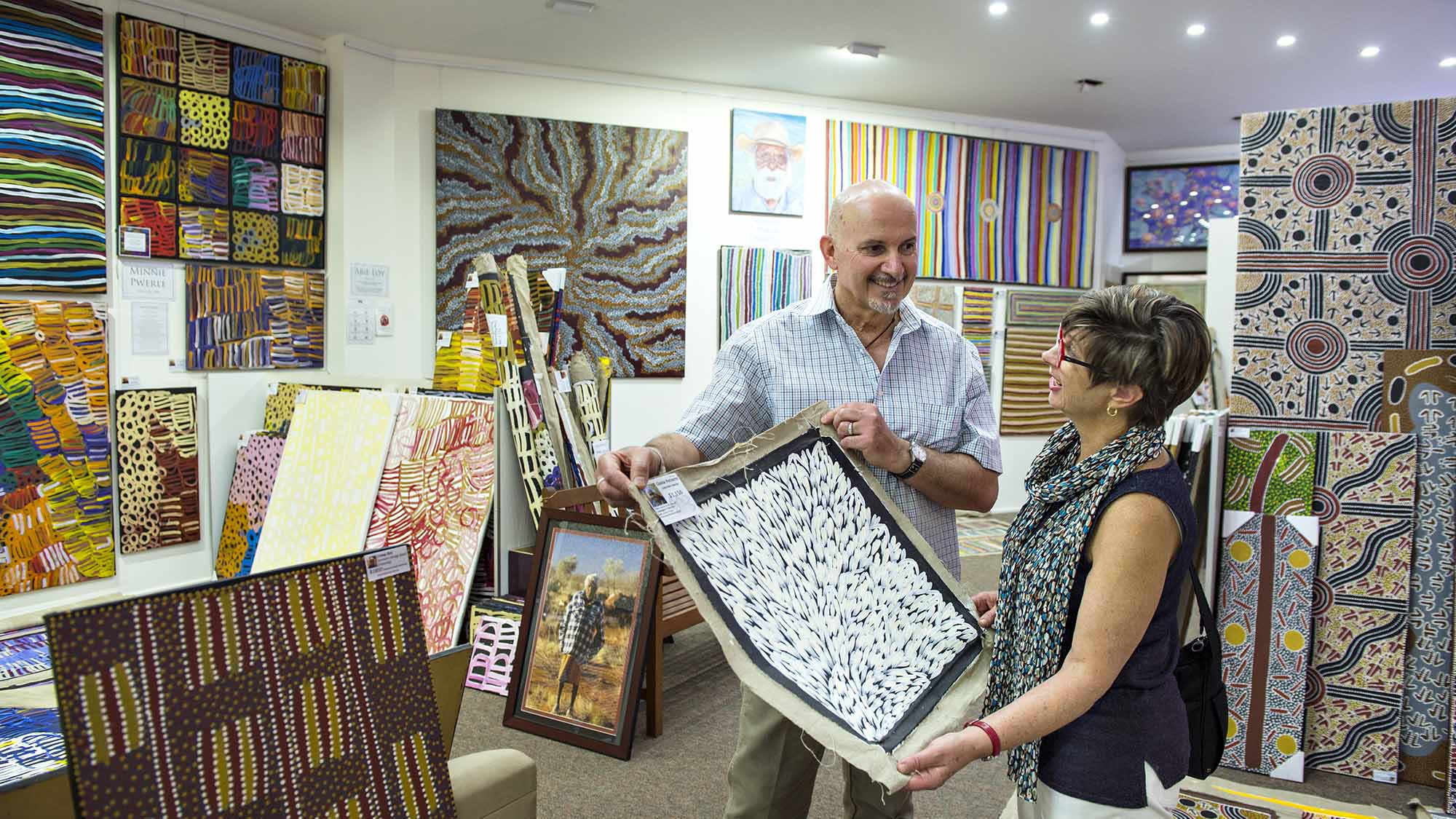
Image: Take a piece of Alice Springs home with you from the Mbantu Fine Art Gallery and Cultural Museum (credit Shaana McNaught & Tourism NT)
Natural wonders to explore
Tjoritja West MacDonnell National Park stretches for 161 kilometres west of Alice Springs. Explore and appreciate the scenic beauty and history of the area on foot, swim in a waterhole, or pitch a tent for a longer stay. Take a dip in the cold waters of one the park's permanent water holes. The larger water holes include Ellery Creek Big Hole, Ormiston Gorge, Redbank Gorge and Glen Helen Gorge. The park encompasses an ancient landscape sculpted over time by climatic elements. It is also a refuge for rare and threatened plants as well as wildlife, including the uncommon bird species such as the Peregrine Falcon. Features of the landscape are significant to the Arrernte people, including the Ochre Pits that have long been a quarry for important ochre pigments.
Located 18 kilometres from Alice Springs, Simpson’s Gap is one of the most prominent gaps in the West MacDonnell Ranges and features the towering cliffs of Simpsons Range, a permanent waterhole, and opportunities to spot resident wildlife. At dawn and dusk you might see Black-footed Rock-wallabies along the walking track into the gap. Vegetation typical of the MacDonnell Ranges is found in the area, including large stands of Mulga and over 40 rare and relict plants. There are many short walks that pass the native plants of the area including ancient Ghost Gums and to views of the range.
Like its westerly twin, the East MacDonnell Ranges stretch 150 km east of Alice Springs and hide some of Central Australia’s most famous outback landscapes—gaps, gorges, bush walks, Aboriginal art and amazing geological formations. You’ll find popular destinations like Ruby Gap Nature Park, Winnecke Goldfield Cemetery, N’Dhala Gorge Nature Park and Arltunga Historial Reserve. The road is sealed for the first 75 km (to Trephina Gorge), so you can pack a picnic and take a day trip to see some of the East’s attractions in a normal car. If you have time, take a swag or a tent to camp in some of the Centre’s most scenic spots.
The Simpson Desert is a vast expanse of rolling dunes, seemingly endless horizons and deep red sand. See the brilliant wildflowers, rare pine trees and unique wildlife that thrives in the harsh desert environment. Rainbow Valley within the desert is a spectacular sandstone bluff with bands of colour that is at its most spectacular in the early or late light of the day. Chambers Pillar is a towering 50-metre column of pebbly sandstone – all that remains after 350 million years of wind and rain erosion. At Ewaninga Rock Carvings Conservation Reserve ancient rock carvings and petroglyphs are a fascinating record of the beliefs of the local Arrernte people.

Image: The mesmerising oranges of Glen Helen Gorge in Tjoritja West MacDonnell National Park (credit Paddy Palin and Tourism NT)
Header Image: The view from Anzac Hill, Alice Springs (credit Shaana McNaught & Tourism NT)
